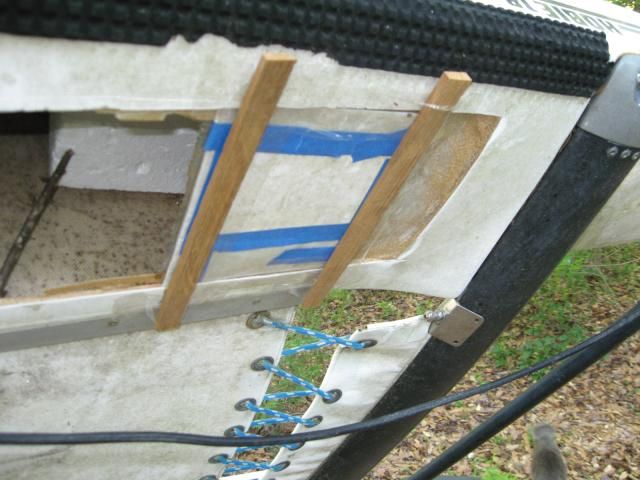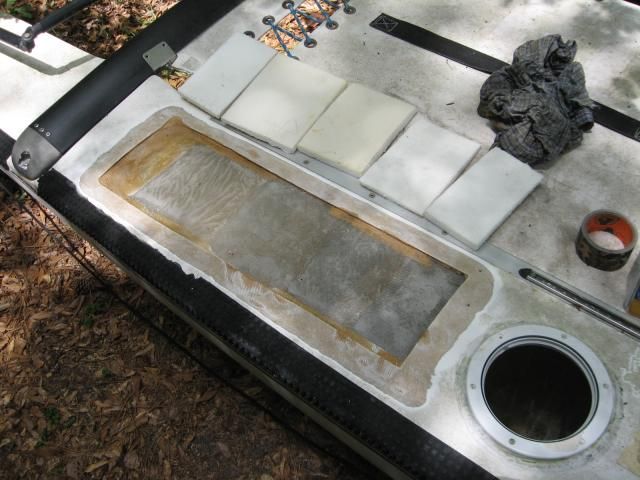I know this is very common topic but my searches didn't get me the answers I was looking for. Thanks!
My H18 has the common soft spot on deck from rear cross beam to dagger board well. Can I just drill and fill or should I pull up inner glass with screws?
With either method I thought polyester resin would be the correct filler but reading through the technical tips I saw epoxy thickened to ketchup consistency was used. Which is better?
Delam, thickened epoxy vs polyester resin?

-
- Rank: Mate
- Registered: Sep 25, 2010
- Last visit: Oct 12, 2023
- Posts: 180
-
- Rank: Mate
- Registered: Dec 01, 2011
- Last visit: Nov 02, 2016
- Posts: 165
Git-rot is a way to go. It has better penetration than regular Epoxy. Epoxy has superior adhesion comparing to Polyester. If your soft spot is as big as you describe, it is beyond repair. Your money may be better spend for a used hull.
Pictures?
--
Jack B
Hobie 17
BC, Canada
-- -
- Rank: Mate
- Registered: Sep 25, 2010
- Last visit: Oct 12, 2023
- Posts: 180
I've been looking for new hulls but it's hard to find hulls in good shape without buying an entire boat... Also not a lot of cats in New England. I know exactly when my soft spot occurred, Last season I stepped onto the boat from the dock and heard a LOUD crunch sound, from then on the starboard deck was soft. I don’t believe it's beyond repair... it may not be optimal when fixed but I'm sure it will float, lol.
I've read the arguments for and against git-rot. I heard git-rot is mildly flexible when cured whereas polyester is rock hard. I thought polyester was the correct material vs. epoxy because it's what the hulls were made with originally.
Also, rather than using screws what if I were to drill holes straight through the deck and sandwich it with strips of wood and small bolts? Then remove the wood after it cures. -
- Rank: Lubber
- Registered: Jan 09, 2012
- Last visit: May 17, 2013
- Posts: 78
As stated before, the epoxy will have better adhesion giving the best possible results between polyester resin and epoxy. I did the screws through the top layer, holding the inner layer without any wooden blocks and the screws had no problem coming out to finish the job after the bulk of the epoxy injection was done. -
- Rank: Mate
- Registered: Sep 25, 2010
- Last visit: Oct 12, 2023
- Posts: 180
-
- Rank: Mate
- Registered: Aug 22, 2007
- Last visit: Jan 07, 2015
- Posts: 742
-- I HAVEN'T REPAIRED A DECK DELAM --
...so take it fwiw:
If you're thinking of putting it under vacuum like the guy in the other thread just showed, you're not going to want it thickened.
However, if you're injecting by hand, it's really your call. Just about anything is cheaper, and lighter, than epoxy, so you can save some money by adding bulk to it, but considering you're trying to push it into all of the delam'ed areas, you're not going to want a lot of viscosity. You can get one hell of a hard and sticky substance w/ fillers like West's 404, but you'd want to make sure all of your holes are taped off very well, as you're not going to sand that stuff down without sanding your deck off. A fairing compound would go the other direction w/ all that.
Again, I haven't done it, but if I had to, I'd probably try to thicken minimally (to try to make sure I've got resin touching both the top and bottom of the delam'ed space) w/ something like a blend of west's 404/406 (I have & use a different brand of fillers) or else milled fibers. I've used milled fibers and the mixture seems to flow OK, and all things considered that's probably exactly what should be in there, but I don't hear about people using them too often. It also cures pretty darned hard.
No matter what you use (epoxy-wise), as long as you DO get good adhesion between the layers, the difference will likely be how expensive and how difficult the process was, not the results.
I would not use polyester resin for this. Aside from price I can't think of an upside at all compared to epoxy. This is the type of thing epoxy is perfectly suited for.
--
Rob
OKC
Pile of Nacra parts..
-- -
- Rank: Mate
- Registered: Jul 20, 2011
- Last visit: Apr 07, 2019
- Posts: 323
For my several delamination jobs I've used non thickened epoxy - slow cure. It flows easier between the glass layers very well, penetrates deep into the foam and gives you extra working time to refill bottles ( the mustard/ketchup style you get from the dollar store work great. The decks on my H16's are rock solid now.
Here's what I use.
http://www.jamestowndistributors.com/mobileportal/show_product.do?pid=64343&familyName=TotalBoat+5%3A1+Epoxy+Kits
Tim
--
Tim Grover
1996 Hobie Miracle 20
Two Hobie 14's
1983 G-Cat Restored
Memphis TN / North Mississippi
-- -
- Rank: Lubber
- Registered: Oct 01, 2004
- Last visit: May 20, 2013
- Posts: 7
Injected epoxy will be heavy and very brittle, a bad feature in a deck. If you heard a crack more than likely your core and inner skin is broken. I know alot get by with this but not much more effort to fix it right. I did the exact same repair last year. When I get home later I will post some pics and explain in more detail. -
- Rank: Lubber
- Registered: Oct 01, 2004
- Last visit: May 20, 2013
- Posts: 7
When I cut my top deck off I was expecting to find just a delamed core,but instead the core and glass were completely cracked.

The inner skin is just 10oz glass maybe less and I wanted to rebuild a little stronger. I used 1708 biax./Vinlyester resin
I used the old skin as a mold and worked my way out in little sections. I used a stick to hold the foam block out of my way.

I cut the new core out of the tail of a surfboard blank

I already had that port from a previous dagger repair so it was easy to work my way out.

I glued in the new core with thickened resin and reglassed with one layer of 1708 on the top and regelcoated. -
- Rank: Mate
- Registered: Jul 20, 2011
- Last visit: Apr 07, 2019
- Posts: 323
Oh my. I think I'd be looking for a new(er) hull at that point.
On the repairs I've done I've tested the epoxy on a scrap peice of wood then scraped it off and tried to crack it. It's still a tiny bit flexible after curing, git-rot is even more flexible after curing. If you're doing delam repairs there's a good chance your hulls are 30+ years old. An extra pound or two to make a hull solid and safe is a minor side effect. I try to make my hulls fail every time I sail and inspect them thoroughly each time and they remain solid with no issues other than cosmetic. On an older boat I say go for it then sail the crap out of it. When the funds allow, buy a newer boat that's in super great shape.
Tim
--
Tim Grover
1996 Hobie Miracle 20
Two Hobie 14's
1983 G-Cat Restored
Memphis TN / North Mississippi
-- -
- Rank: Lubber
- Registered: Oct 01, 2004
- Last visit: May 20, 2013
- Posts: 7
I wouldnt be looking for a new(er) hull unless the soft spots were in front of the crossbars or along the hull sides. On a H18 this area gets the most abuse. If his inner skin is cracked epoxy injection is not going to work. I think he is a long way off before he needs to start looking for another hull. This repair was actually pretty simple(granted I do alot of glass work). Glad your repairs are working for you but if you have ever pushed an H18 up the beach adding any weight at all is a bad idea
-
- Rank: Lubber
- Registered: Jun 03, 2012
- Last visit: Jun 08, 2014
- Posts: 55
I had 1 hull that had a 3'x6' section that was soft. I used regular poly resin from wally world. After a little over 1.5 quarts, I consider it better than new, super strong.
--
16' Prindle
Emerald Coast of Florida
--
Users on-line
- 0 users
This list is based on users active over the last 60 minutes.


